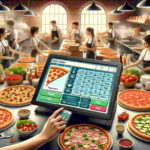Difference Between Traditional vs Cloud Based ePOS Systems
POS has eased many restaurants’ work; however, many businesses still hesitate to use a POS system. There are many reasons for this, as there is confusion regarding traditional and cloud based ePOS system.
Let us see the differences between the two systems.
1) Software – Traditional ePOS system must be installed on the local database. It does not depend on an internet connection. It works on a stand-alone system and all data is available in that single system. However, cloud based ePOS system host the restaurant database online. This system requires a fast and reliable internet connection always to operate.
2) Support – Both the traditional and cloud based ePOS system requires support for various hardware issues. In the traditional system, support can happen through the telephone to some extent. However, for cloud-based system, the support activities can take place remotely. All activities like installation and troubleshooting happen remotely and need not have on-site support actions.
3) Storage – Traditional ePOS systems require the database to be on the local host. The database has to be on one of the ePOS terminals for small restaurants and a server for larger ones. This setup does not require any internet connection, and files and data are easily accessible from a single location. In this set-up, the entire operations are dependent on a single system or a local network. However, cloud solutions store all files and data on remote servers. It can be accessed only through the internet. So, when there is no internet, the restaurant will be in at mess.
4) Integration – Integrated solutions are necessary for faster processing. With a traditional POS system, it is challenging to integrate new modules as it takes a lot of time to customize them. During that time, entire operations are interrupted, and the business uses it without any alteration. However, the cloud ePOS system helps to integrate new modules easily without any errors. Having a cloud-based system is easy to adapt based on restaurant operations and size. A few functionalities that you can easily integrate with a cloud-based system are accounting, CRM, loyalty programs, etc.
5) Data Accessibility – Using a traditional system, only data from on-site can be accessible. It means that the data owner has to be present physically on the site to operate back-office. All restaurant data is available in one location; hence data and reports can be pulled only from one location. However, using a cloud-based system, data is accessible from any location and anytime when required. It can also be accessed from any device having an internet connection. Also, data can be updated and saved from anywhere. Data that is stored in the cloud server syncs in real-time with the primary device. Users can view data in real-time.
6) Data Risk – With the traditional POS system, there is a risk of data loss. As all the data and operations take place using a single system, if that system crashes or gets a bug, data is lost. Data loss is a big risk to any business and it is also a tough task for data retrieval. However, cloud-based system has an advantage over this feature. Here, data gets backed up in the cloud server automatically. So, even if data is lost or the local system crashes, there are ways to restore it.
7) Cost – The traditional POS system requires high upfront costs and there are expenses involved in setting up the hardware. Also, the system should be updated manually on-site every time. So, it incurs some IT infrastructure costs explicitly. It also requires extra maintenance. When the system crashes, then there will cost of re-installation as well. However, cloud based ePOS system works on a subscription basis, either monthly or yearly. There are fewer upfront costs as the installation is easy and the maintenance happens remotely. There are also up-gradation fees because the cloud service providers keep updating the server automatically. Also, the back-office servers store legacy data and it cost high. Depending on the number of users, devices, and operation size, cloud services can be as expensive as traditional systems.
In the end, each system performs the same function, streamlining restaurant operations and automating all the activities inside.





